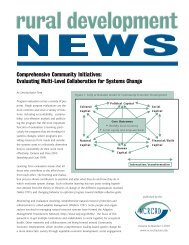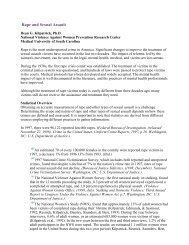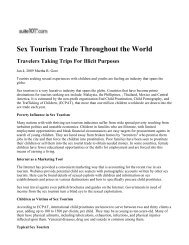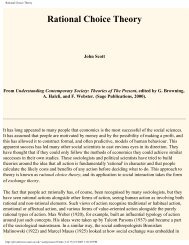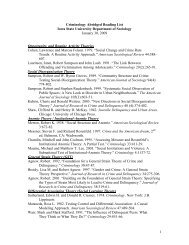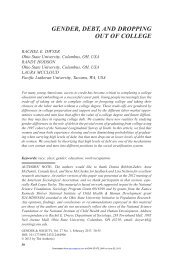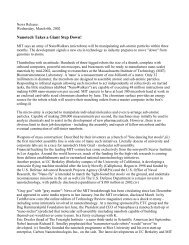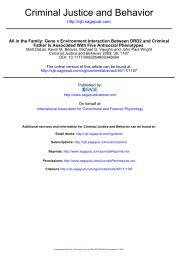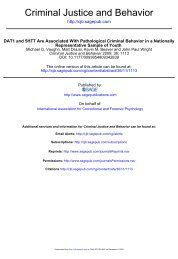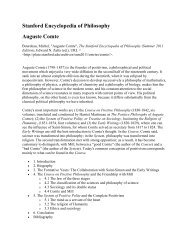Kevin M. Beaver, Chris L. Gibson, Michael G. Turner, Matt DeLisi ...
Kevin M. Beaver, Chris L. Gibson, Michael G. Turner, Matt DeLisi ...
Kevin M. Beaver, Chris L. Gibson, Michael G. Turner, Matt DeLisi ...
You also want an ePaper? Increase the reach of your titles
YUMPU automatically turns print PDFs into web optimized ePapers that Google loves.
Crime & Delinquency<br />
http://cad.sagepub.com/<br />
Stability of Delinquent Peer Associations : A Biosocial Test of Warr's<br />
Sticky-Friends Hypothesis<br />
<strong>Kevin</strong> M. <strong>Beaver</strong>, <strong>Chris</strong> L. <strong>Gibson</strong>, <strong>Michael</strong> G. <strong>Turner</strong>, <strong>Matt</strong> <strong>DeLisi</strong>, <strong>Michael</strong> G.<br />
Vaughn and Ashleigh Holand<br />
Crime & Delinquency 2011 57: 907 originally published online 10 April 2009<br />
DOI: 10.1177/0011128709332660<br />
The online version of this article can be found at:<br />
http://cad.sagepub.com/content/57/6/907<br />
Published by:<br />
http://www.sagepublications.com<br />
Additional services and information for Crime & Delinquency can be found at:<br />
Email Alerts: http://cad.sagepub.com/cgi/alerts<br />
Subscriptions: http://cad.sagepub.com/subscriptions<br />
Reprints: http://www.sagepub.com/journalsReprints.nav<br />
Permissions: http://www.sagepub.com/journalsPermissions.nav<br />
Citations: http://cad.sagepub.com/content/57/6/907.refs.html<br />
>> Version of Record - Oct 14, 2011<br />
Proof - Apr 10, 2009<br />
What is This<br />
Downloaded from cad.sagepub.com at IOWA STATE UNIV on October 14, 2011
XXX10.1177/0011128709332660DuweCrime & Delinquency<br />
© The Author(s) 2011<br />
Article<br />
Stability of Delinquent<br />
Peer Associations:<br />
A Biosocial Test<br />
of Warr’s Sticky-Friends<br />
Hypothesis<br />
Crime & Delinquency<br />
57(6) 907 –927<br />
© The Author(s) 2011<br />
Reprints and permission: http://www.<br />
sagepub.com/journalsPermissions.nav<br />
DOI: 10.1177/0011128709332660<br />
http://cad.sagepub.com<br />
<strong>Kevin</strong> M. <strong>Beaver</strong>, 1 <strong>Chris</strong> L. <strong>Gibson</strong>, 2<br />
<strong>Michael</strong> G. <strong>Turner</strong>, 3 <strong>Matt</strong> <strong>DeLisi</strong>, 4<br />
<strong>Michael</strong> G. Vaughn, 5 and Ashleigh Holand 6<br />
Abstract<br />
The study of delinquent peers has remained at the forefront of much<br />
criminological research and theorizing. One issue of particular importance<br />
involves the factors related to why people associate with and maintain a<br />
sustained involvement with delinquent peers. Although efforts have been<br />
made to address these questions, relatively little attempt has been made to<br />
understand these relationships from a biosocial perspective. This gap in the<br />
literature is addressed in an analysis of twins from the National Longitudinal<br />
Study of Adolescent Health (Add Health). The results of the univariate<br />
behavioral genetic models reveal that genetic factors account for between<br />
58% and 74% of the variance in the association with delinquent peers, with<br />
the remaining variance attributable to environmental factors. Bivariate Cholesky<br />
decomposition models reveal that genetic factors account for 58% of<br />
the variance in the stability in delinquent peers. The shared environment<br />
1 Florida State University, Tallahassee<br />
2 University of Florida, Gainesville<br />
3 University of North Carolina at Charlotte<br />
4 Iowa State University, Ames<br />
5 Saint Louis University, St. Louis, MO<br />
6 Florida State University, Tallahassee<br />
Corresponding Author:<br />
<strong>Kevin</strong> M. <strong>Beaver</strong>, PhD, Florida State University, College of Criminology and Criminal Justice,<br />
634 West Call Street, Tallahassee, FL 32306-1127.<br />
Downloaded from cad.sagepub.com at IOWA STATE UNIV on October 14, 2011
908 Crime & Delinquency 57(6)<br />
explains 34% of the variance in stability, and the remaining 8% is attributable<br />
to the nonshared environment. The importance of a biosocial approach in<br />
criminological research is discussed.<br />
Keywords<br />
biosocial criminology, delinquency, delinquent peers, environment, genetics<br />
Biological and environmental explanations of crime and delinquency have<br />
historically remained separate, with relatively little attempt at integrating<br />
these two perspectives. This has changed in recent years as a number of criminologists<br />
have called for a biosocial criminology that seeks to introduce biological<br />
concepts into existing criminological theories and research (Walsh,<br />
2002a; Walsh & <strong>Beaver</strong>, 2009; Walsh & Ellis, 2003). In response to the attention<br />
these scholars have raised regarding the biosocial perspective, empirical<br />
research has been increasingly gaining momentum and providing the foundation<br />
for some of the most influential theories in recent decades (<strong>Beaver</strong> &<br />
Wright, 2005; <strong>Beaver</strong>, Wright, & <strong>DeLisi</strong>, 2008; Moffitt, 1993). Still, there<br />
remains much resistance to this scholarly interest in advancing our understanding<br />
of the causes of delinquency and crime. Part of the reason for such<br />
opposition is because within mainstream criminology there has been relatively<br />
little empirical work showing the ways in which biological and genetic<br />
factors can complement and add clarity to some key environmental correlates<br />
of criminality.<br />
Nowhere is this more evident than in studies examining the nexus between<br />
delinquent peers and delinquent involvement (Walsh, 2002b). Of all the<br />
criminological variables available, measures of delinquent peers are often<br />
viewed as the “purest” social variables, because they are assumed to be<br />
orthogonal with biological and genetic factors. At first glance, this seems<br />
intuitively obvious; after all, how could genetic factors contribute to delinquent<br />
peer group formation However, further inspection reveals a number of reasons<br />
to suspect that friendship networks, including antisocial friendship networks,<br />
are influenced, at least in part, by genetic factors. Moreover, there is good<br />
reason to suspect that contact with delinquent peers over time is partially<br />
shaped by genetic factors.<br />
The current study explores these issues by applying a biosocial framework<br />
to the study of delinquent peers and, more specifically, to Warr’s “stickyfriends”<br />
hypothesis. To do so, we estimate models that partition the variance<br />
explaining the association with delinquent peers and the stability in these<br />
associations into genetic, shared, and nonshared environmental influences.<br />
Downloaded from cad.sagepub.com at IOWA STATE UNIV on October 14, 2011
<strong>Beaver</strong> et al. 909<br />
Empirical investigation of these concerns is important because no research to<br />
date has decomposed the biological and environmental sources of variance in<br />
regard to Warr’s sticky-friends thesis.<br />
Association With Delinquent Peers<br />
Criminologists have conducted a considerable amount of research investigating<br />
the influence of peers, particularly delinquent peers, in the causes of delinquency.<br />
This extensive level of inquiry should come as no surprise because the extant<br />
research has documented that a significant amount of delinquency transpires in<br />
the presence of co-offending peers (Conway & McCord, 2002; Reiss, 1988) or<br />
via an offender’s involvement with gangs (Klein, 1995). As a result, scholars<br />
have focused on the outcomes of possessing or associating with delinquent<br />
peers or some other variant affiliated with the delinquent peer structure. For<br />
example, research has focused on such areas as the quality of friendships<br />
(Giordano, Cernkovich, Groat, Pugh, & Swinford, 1998), the importance of<br />
friendship networks (Haynie & Payne, 2006), the effects of peers on group and<br />
solo offending (Hochstetler, Copes, & <strong>DeLisi</strong>, 2002), and the temporal nature<br />
of peers in relation to the onset of delinquency (Elliott & Menard, 1996).<br />
Much less research, however, has explored the factors that influence how<br />
individuals acquire or associate with delinquent peers. When we consider the<br />
number and types of sources of delinquent peer formation, it makes intuitive<br />
sense that environmental influences remain at the nexus of such explanations.<br />
For example, Warr (1993) provides evidence suggesting that adolescents’<br />
attachment to their parents affects the acquisition of delinquent peers. In more<br />
recent research, Warr (2005) empirically verifies how parent–child relations,<br />
particularly in the form of direct and indirect parental supervision, emerge as<br />
significant contributors in the process of making delinquent friends. Similarly,<br />
Thornberry (1987) provided theoretical articulation and empirical evidence<br />
that the acquisition of delinquent peers occurs in a reciprocal or interactive<br />
process. That is, the association with delinquent peers is found to be a result of<br />
diminished parental attachment and a reduced commitment to school, two very<br />
prominent environmental sources. The common thread that weaves each of<br />
these perspectives together is the level of importance given to environmental<br />
sources and the level of absence given to biological sources.<br />
Warr’s Sticky-Friends Hypothesis<br />
Warr (1993) examined whether the well-known age–crime curve could be<br />
explained via patterns of exposure to delinquent peers. By analyzing data from<br />
the National Youth Survey (NYS), Warr showed that the ebb and flow of<br />
Downloaded from cad.sagepub.com at IOWA STATE UNIV on October 14, 2011
910 Crime & Delinquency 57(6)<br />
delinquent involvement was mirrored by changes in delinquent peer exposure.<br />
When delinquent involvement begins to increase, so too does contact with<br />
antisocial peers; when delinquent involvement begins to decrease, so too does<br />
contact with antisocial peers. Moreover, Warr calculated a number of regression<br />
equations showing that once measures of delinquent peers were introduced<br />
into the models, the effect of age on delinquency was reduced to statistical<br />
insignificance or attenuated substantially. Warr’s analysis of the NYS thus<br />
provided initial evidence that the age–crime curve could perhaps be explained<br />
partially by changes in delinquent peer exposure over time.<br />
One of the more important yet frequently overlooked contributions of<br />
Warr’s (1993) study was his recognition that exposure to delinquent peers was<br />
highly stable during adolescence, a phenomenon that he referred to as “sticky<br />
friends.” Warr (1993) captured the essence of what he meant by sticky friends<br />
when he said, “Delinquent friends, once acquired, are not lost in subsequent<br />
years” (p. 31). He continued by stating that the NYS data “demonstrate a<br />
general, though far from universal, tendency for adolescents to retain delinquent<br />
friends once they have been acquired” (pp. 32-33).<br />
Although Warr’s sticky-friends hypothesis is of great importance to<br />
criminologists, there are two main shortcoming associated with it. First, there<br />
has been a general lack of empirical research testing the merits of the stickyfriends<br />
hypothesis (but see Mears & Field, 2002). This necessarily raises the<br />
question of whether the “stickiness” of delinquent peers would be observed<br />
in different samples. We address this gap in the literature by analyzing data<br />
from the National Longitudinal Study of Adolescent Health (Add Health).<br />
The second drawback to the sticky-friends hypothesis is that the underlying<br />
mechanisms that can explain why friends are “sticky” were not well developed<br />
by Warr. Part of the reason that he did not explicate all of the potential<br />
mechanisms that account for the stickiness in friends is because there are<br />
numerous ways to explain this phenomenon. Warr pointed out that sticky<br />
friends could be explained by labeling theory and by subcultural theories.<br />
Indeed, the argument could be made that most existing criminological theories<br />
could provide a viable explanation for sticky friends. Even so, we explore the<br />
ways that just one perspective—a biosocial perspective—can be used to<br />
explain why delinquent peers are sticky.<br />
A Biosocial Explanation<br />
for Warr’s Sticky-Friends Hypothesis<br />
Exposure to certain environments is often the result of selection processes,<br />
where latent factors influence the choice of one environment over another<br />
Downloaded from cad.sagepub.com at IOWA STATE UNIV on October 14, 2011
<strong>Beaver</strong> et al. 911<br />
(Gottfredson & Hirschi, 1990). Within criminology, selection effects are often<br />
tied to personality traits, especially low self-control. Research from other<br />
disciplines, however, has identified genetic factors as also contributing to<br />
selection effects. According to this line of inquiry, genetic factors influence<br />
personality traits, including self-control, and these personality traits in turn<br />
are partially responsible for selection into certain environments (Jaffee &<br />
Price, 2007).<br />
To understand exactly how genes may ultimately influence exposure to<br />
environments, it is necessary to introduce gene X environment correlations.<br />
Gene X environment correlations delineate three different ways that genes<br />
and environments are correlated (Walsh, 2002a). The first type of gene X<br />
environment correlation is referred to as a passive gene X environment<br />
correlation. Passive gene X environment correlations are grounded in the<br />
fact that children usually receive their environment and their genes from<br />
their parents. Typically, the environment with which they are born into is<br />
correlated with their genetic tendencies. For example, research has revealed<br />
that criminal parents are likely to provide a criminogenic environment to<br />
their children (Farrington & Welsh, 2007). Research has revealed that<br />
antisocial predispositions are transmitted genetically (Moffitt, 2005; Walsh,<br />
2002a; Wright & <strong>Beaver</strong>, 2005). The end result is that a child’s home<br />
environment, especially early in life, matches his or her genetic tendencies.<br />
The second way that genes and the environment may be associated is through<br />
evocative gene X environment correlations. Evocative gene X environment<br />
correlations are grounded in logic showing that persons elicit certain responses<br />
from their environment based, in part, on their own unique temperament. For<br />
example, disorderly and defiant children are more apt to be punished by their<br />
parents than are obedient children (<strong>Beaver</strong> & Wright, 2007; Huh, Tristan,<br />
Wade, & Stice, 2006; Lytton, 1990). Part of the reason that some children are<br />
well behaved and some children are aggressive and violent is because of<br />
genetic factors (Arseneault et al., 2003). What happens, then, is that genetic<br />
factors predispose to certain temperaments and these temperaments in turn<br />
ultimately evoke responses from the environment.<br />
Active gene X environment correlations are the third type of gene X<br />
environment correlation. Active gene X environment correlations are based<br />
on research showing that persons are active agents in selecting and choosing<br />
environments that are compatible with and reinforced by their personality and<br />
behavior (Scarr, 1992; Scarr & McCartney, 1983). People, for example, tend<br />
to seek out others who share similar beliefs, talents, behaviors, and personality<br />
traits. Moreover, there is evidence showing that people mate assortatively—that<br />
is, they seek out others to marry who have similar characteristics. For example,<br />
Downloaded from cad.sagepub.com at IOWA STATE UNIV on October 14, 2011
912 Crime & Delinquency 57(6)<br />
research has revealed that antisocial persons tend to marry antisocial spouses<br />
(Krueger, Moffitt, Caspi, Bleske, & Silva, 1998). In this way, genetic factors<br />
influence individual characteristics, and these characteristics nudge people into<br />
one environment or another.<br />
Of the three types of gene X environment correlations, active gene X<br />
environment correlations are the most applicable to Warr’s sticky-friends<br />
hypothesis. In line with the logic of active gene X environment correlations,<br />
genetically influenced individual differences may propel some adolescents to<br />
seek out delinquent peers to befriend. Other adolescents who have a different<br />
suite of genetic factors that correspond to a different suite of individual<br />
differences may seek out prosocial adolescent friendship networks. The<br />
important point is that genetic factors, via their effects on personality and<br />
behavior, lead to differential exposure to delinquent peers. If this is the case,<br />
then genetic factors that promote contact with delinquent peers at one point<br />
in time should also have effects at another time point. The available research<br />
tends to provide some support for this view.<br />
Kendler and his colleagues (2007), for instance, analyzed longitudinal data<br />
from the Virginia Twin Registry to examine the effect that the environment<br />
and genes had on delinquent peer group associations from childhood through<br />
adulthood. The results of their models revealed that genetic factors accounted<br />
for roughly 30% of the variance in peer-group deviance in childhood. Over<br />
time, however, genetic effects on delinquent peers became even stronger and<br />
accounted for approximately 50% of the variance in peer-group deviance.<br />
Kendler et al. (2007) pointed out that environmental conditions were important<br />
contributors to delinquent peer affiliations. At every time period, environmental<br />
effects accounted for approximately 50% of the variance in peer-group<br />
deviance. Other studies have revealed that both genetic and environmental<br />
factors contribute to the formation of antisocial peer groups (<strong>Beaver</strong> et al.,<br />
2008; Cleveland, Wiebe, & Rowe, 2005; Iervolino et al., 2002; Rowe, Rodgers,<br />
& Meseck-Bushey, 1992). The point is that over a period of development,<br />
certain genetic factors and certain environmental factors remain relatively<br />
stable. The stability in these factors may lead a person to seek out the same<br />
types of friends at different time periods. The existing literature indicates that<br />
environmental factors contribute to stability in delinquent peers, but so too do<br />
genetic factors.<br />
The Current Study<br />
It is clear that the extant literature implicates both environmental factors and<br />
genetic factors in delinquent peer associations. No research, however, has<br />
Downloaded from cad.sagepub.com at IOWA STATE UNIV on October 14, 2011
<strong>Beaver</strong> et al. 913<br />
examined the extent to which stability in delinquent peers—or sticky friends—<br />
is attributable to genetic and environmental factors. We address this gap in the<br />
literature by using twins from the National Longitudinal Study of Adolescent<br />
Health (Add Health) to empirically investigate three hypotheses. First, we<br />
hypothesize that genetic and environmental factors will explain a significant<br />
amount of variance in the association of antisocial friends. Second, and<br />
consistent with Warr’s sticky-friends hypothesis, we anticipate that contact<br />
with delinquent peers will be relatively stable during adolescence. Third, we<br />
hypothesize that genetic and environmental factors will explain a significant<br />
amount of variance in the stability of delinquent peers—that is, we suspect that<br />
the sticky-friends phenomenon is a biosocial one sustained by a complex<br />
arrangement of genetic and environmental factors.<br />
Methods<br />
Data<br />
Data for this study come from the National Longitudinal Study of Adolescent<br />
Health (Add Health), which is a nationally representative sample of American<br />
adolescents in grades 7 through 12 (Udry, 2003). Participants in the Add<br />
Health study have been followed longitudinally from adolescence to young<br />
adulthood and have been interviewed three times thus far. Initial data collection<br />
efforts began in 1994-1995, when most of the respondents were between the<br />
ages of 12 and 18 years. To select a nationally representative sample of youths,<br />
multistage stratified sampling techniques were employed. Using this sampling<br />
procedure, 132 middle schools and high schools were selected for inclusion in<br />
the study. During 1994, more than 90,000 students enrolled at these schools<br />
were administered a self-report survey. To conduct more in-depth interviews<br />
with some of the adolescents, a subsample of 20,745 respondents and 17,700<br />
of their primary caregivers (usually the mother) were re-interviewed in the<br />
youth’s home. Questions were asked to both the youth and their caregiver to<br />
gather detailed information about the adolescent’s peer groups, delinquent<br />
involvement, risky behaviors, and family experiences, among others (Harris<br />
et al., 2003).<br />
Approximately 1 year later, the second wave of questionnaires was<br />
administered to 14,738 of the original Wave 1 participants. Many of the<br />
same questions that were asked to respondents at Wave 1 were also asked at<br />
the Wave 2 interviews. For example, items indexing the youth’s friendship<br />
networks, their drug and alcohol abuse, and their social relationships were<br />
included in the Wave 2 questionnaire. A third wave of data were collected<br />
Downloaded from cad.sagepub.com at IOWA STATE UNIV on October 14, 2011
914 Crime & Delinquency 57(6)<br />
nearly 5 years after the second round of interviews was conducted. Because<br />
most of the respondents were in their early to mid-20s at Wave 3, the survey<br />
instrument was redesigned to include questions that were more age appropriate.<br />
Questions pertaining to marital status, childbearing history, and contact with<br />
the criminal justice system were included in the Wave 3 survey. In total, 15,197<br />
participants were re-interviewed at Wave 3 (Harris et al., 2003).<br />
Siblings were oversampled for inclusion in the Add Health study (Harris<br />
et al., 2003). During Wave 1 interviews, adolescents were asked whether they<br />
lived with a co-twin, a half-sibling, an unrelated sibling (e.g., a stepsibling),<br />
or a cousin. If they responded yes and if their sibling was 11 to 20 years of<br />
age, then their sibling was added to the sample. In addition, a probability<br />
sample of full biological siblings was selected to take part in the study<br />
(Jacobson & Rowe, 1999). Overall, 3,139 sibling pairs were included in<br />
the Add Health data, and a recent analysis revealed that the demographic<br />
characteristics for the sibling-pairs data were comparable to those of the larger<br />
Add Health sample (Jacobson & Rowe, 1998). We restrict our final analytical<br />
sample to data that were collected from same-sex dizogytic twin pairs and from<br />
monozygotic twin pairs. After deleting twins whose zygosity was unattainable<br />
or unavailable, we were left with a final sample size of (N = 537) twin pairs,<br />
(n = 248) same-sex dizygotic (DZ) twin pairs, and (n = 289) monozygotic<br />
(MZ) twin pairs.<br />
Measurement of Delinquent Peers<br />
Three measures tapping the respondent’s affiliation with delinquent peers are<br />
available in the Wave 1 data, and the same three items are available in the<br />
Wave 2 data. 1 At both waves, respondents were asked to indicate how many<br />
of their three closest friends smoked at least one cigarette each day, smoked<br />
marijuana at least once each month, and got drunk at least once each month.<br />
For each question, responses were coded as 0 = 0 friends, 1 = 1 friend, 2 = 2<br />
friends, and 3 = 3 friends. Researchers analyzing the Add Health data have<br />
found these items to have face validity and to have strong predictive validity<br />
(<strong>Beaver</strong> & Wright, 2005; Bellair, Roscigno, & McNulty, 2003). Even so, a<br />
number of additional statistics were calculated to examine the psychometric<br />
properties of these scales. First, principal components factor analysis and scree<br />
plots indicated that all of the items loaded on a unitary construct. Second,<br />
confirmatory factor analyses were conducted, and the results of these models<br />
revealed that the observable indicators loaded on the same factor. Third,<br />
Cronbach’s alpha was calculated for each of the two scales, and the results<br />
Downloaded from cad.sagepub.com at IOWA STATE UNIV on October 14, 2011
<strong>Beaver</strong> et al. 915<br />
revealed high levels of internal consistency (α = .76 for the Wave 1 delinquent<br />
peers scale; α = .77 for the Wave 2 delinquent peers scale).<br />
The items comprising the Wave 1 and Wave 2 delinquent peers scales tap<br />
peer drug and alcohol use. Unfortunately, the Add Health data do not contain<br />
more detailed self-reported measures indexing other delinquent activities of<br />
the adolescent’s peer groups. Recall, however, that Warr’s (1993) analysis of<br />
the NYS revealed that the sticky-friends phenomenon is most pronounced for<br />
alcohol and marijuana use; as a result, the most direct test of the sticky-friends<br />
hypothesis would use delinquent peers scales that measure peer drug and<br />
alcohol use. As such, the measures of delinquent peers available in the Add<br />
Health data are well suited for examining Warr’s sticky-friends thesis.<br />
Plan of Analysis<br />
The analysis for this study proceeds in a series of linked steps. To begin,<br />
traditional model-fitting techniques were used to decompose the variance in the<br />
Wave 1 and the Wave 2 delinquent peers scale into three different components:<br />
a heritability component (A), a shared environmental component (C), and a<br />
nonshared environmental component (E). Shared environments are any<br />
environmental effects that are the same between siblings; shared environments<br />
make siblings similar to each other. Nonshared environments are any<br />
environmental effects that are different between siblings; these environments<br />
make siblings dissimilar from each other. Figure 1 reveals how these models<br />
are estimated. The left-hand side of the figure contains the model for Twin 1<br />
and the right-hand side of the figure contains the model for the co-twin, Twin 2.<br />
The rectangular boxes indicate the score that each twin received on the<br />
delinquent peers scale. The circles—A, C, and E—are latent factors that provide<br />
estimates of genetic, shared environmental, and nonshared environmental<br />
effects on the delinquent peers scale. Note that the correlation of the<br />
shared environmental factor (C) between twins is constrained to a value<br />
of 1.00 because shared environments are the same for co-twins. The<br />
nonshared environmental factor (E), in contrast, is free to vary because<br />
environments that are not shared are unique to each twin—that is, they<br />
are uncorrelated. Note that the genetic factor (A) is constrained to a value of<br />
1.00 for MZ twins because MZ twins share 100% of their DNA. The genetic<br />
factor between DZ twins, in contrast, is constrained to .50 because DZ twins<br />
share, on average, 50% of their DNA. The model presented in Figure 1 was<br />
calculated separately for the Wave 1 delinquent peers scale and the Wave 2<br />
delinquent peers scale.<br />
Downloaded from cad.sagepub.com at IOWA STATE UNIV on October 14, 2011
916 Crime & Delinquency 57(6)<br />
r = 1.00<br />
r = 1.00; .50<br />
E<br />
C<br />
A<br />
A<br />
C<br />
E<br />
e c a<br />
a<br />
c<br />
e<br />
Twin 1<br />
Twin 2<br />
Figure 1. Basic Univariate Variance Components Model for the Delinquent Peers<br />
Scales<br />
Notes: A = genetic factors, C = shared environmental factors, and E = nonshared environmental<br />
factors.<br />
The univariate model described above estimates genetic, shared environmental,<br />
and nonshared environmental effects on the delinquent peers scales.<br />
Although important, these univariate models are not able to provide any information<br />
about the stability of delinquent peers over time nor are they able to<br />
estimate the contributions of genetic and environmental factors to the stickyfriends<br />
phenomenon. Cholesky decomposition models, however, were developed,<br />
in part, to estimate the genetic and environmental effects on the covariation<br />
between two measures (in this case, the covariation is stability) (Neale &<br />
Cardon, 1992). Figure 2 contains a schematic diagram of the bivariate Cholesky<br />
decomposition model that will be estimated for the delinquent peers scales. Two<br />
aspects of Figure 2 are worthy of explanation. First, the latent factors A1, C1,<br />
and E1 are genetic, shared environmental, and nonshared environmental factors<br />
that are common to both the Wave 1 delinquent peers scale and the Wave 2<br />
delinquent peers scale. The path coefficients of these latent constructs can be<br />
used to estimate the stability in delinquent peers over time, and it is possible to<br />
estimate the degree to which genetic factors and environmental factors contribute<br />
to stability. The total stability is equal to<br />
r = (a11 * a21) + (c11 * c21) + (e11 * e21). (1)<br />
Downloaded from cad.sagepub.com at IOWA STATE UNIV on October 14, 2011
<strong>Beaver</strong> et al. 917<br />
r = 1.00; .50 r = 1.00; .50<br />
A1<br />
a11<br />
a21<br />
A2<br />
a22<br />
A1<br />
a11<br />
a21<br />
A2<br />
a22<br />
DP at Wave 1 for Twin 1<br />
DP at Wave 2 for Twin 1<br />
DP at Wave 1 for Twin 2<br />
DP at Wave 2 for Twin 2<br />
c11<br />
e11<br />
c21<br />
e21<br />
c22<br />
e22<br />
c11<br />
e11<br />
c21<br />
e21<br />
c22<br />
e22<br />
C1<br />
E1<br />
C2<br />
E2<br />
C1<br />
E1<br />
C2<br />
E2<br />
r = 1.00 r = 1.00<br />
Figure 2. Bivariate Cholesky Decomposition Model for the Stability in Delinquent<br />
Peers<br />
Notes: DP = delinquent peers; A1, C1, and E1 = genetic, shared, and nonshared environmental<br />
effects common to delinquent peers at Wave 1 and Wave 2. A2, C2, and E2 = genetic, shared,<br />
and nonshared environmental effects unique to delinquent peers at Wave 2.<br />
Equation 1 allows us to estimate the genetic contribution to the covariation.<br />
This is accomplished by taking the product of (a11 * a21) and dividing<br />
it by the total correlation (i.e., r in Equation 1). To estimate shared environmental<br />
effects on stability, the product of (c11 * c21) is divided by r (i.e., r<br />
in Equation 1), and to estimate nonshared environmental effects on stability,<br />
the product of (e11 * e21) is divided by r (i.e., r in Equation 1) (Larsson,<br />
Larsson, & Lichtenstein, 2004; Neale & Cardon, 1992).<br />
Second, bivariate Cholesky models were used to estimate the relative<br />
effects of genetic and environmental factors on changes in delinquent peers.<br />
To do so, the path coefficients a22, c22, and e22 were squared and then added<br />
together. The value was then placed in the denominator in three equations:<br />
one where a22 was in the numerator, one where c22 was in the numerator,<br />
and one where e22 was in the numerator (Neale & Cardon, 1992; for an<br />
application, see Larsson et al., 2004). The values for each of these equations<br />
then provided estimates of the proportion of change in delinquent peers that<br />
was accounted for by genetic factors, shared environmental factors, and<br />
nonshared environmental factors, respectively. The models were calculated<br />
by using the structural equation program Mx, which uses maximum likelihood<br />
Downloaded from cad.sagepub.com at IOWA STATE UNIV on October 14, 2011
918 Crime & Delinquency 57(6)<br />
A<br />
C<br />
E<br />
A<br />
C<br />
E<br />
.58 .31 .11 .74 .16 .10<br />
DP at Wave 1<br />
DP at Wave 2<br />
Figure 3. Results of the Univariate Variance Components Model<br />
Notes: DP = delinquent peers; A = proportion of variance accounted for by genetic factors,<br />
C = proportion of variance accounted for by shared environmental factors, and E = proportion<br />
of variance accounted for by nonshared environmental factors.<br />
estimates (Neale, Boker, Xie, & Maes, 2002). All models were fit to variance–<br />
covariance matrices that had been corrected for measurement error.<br />
Results<br />
We began the analysis by conducting a univariate variance components model<br />
for the Wave 1 delinquent peers scale and for the Wave 2 delinquent peers<br />
scale. A number of alternative models were estimated before arriving at the<br />
final model. Specifically, the latent factors A and C were constrained to zero.<br />
The results of these three models were then compared against each other and<br />
against the full model that did not constrain any of the terms to zero. Then,<br />
Akaike’s information criterion (AIC) was used to determine which model best<br />
fit the data (Larsson et al., 2004). AIC is a function of the model’s overall<br />
goodness of fit and of the model’s parsimony. The model with the smallest<br />
AIC was chosen as the best fitting model, the results of which are presented<br />
in Figure 3.<br />
The left-hand panel of Figure 3 shows the results for the Wave 1 delinquent<br />
peers scale. As can be seen, genetic factors accounted for 58% of the variance<br />
in the Wave 1 delinquent peers scale, whereas shared environmental factors<br />
accounted for 31% of the variance. The remaining 11% of variance in the Wave<br />
1 delinquent peers scale was attributable to nonshared environmental factors.<br />
The results for the Wave 2 delinquency peers scale are contained in the righthand<br />
panel of Figure 3. Genetic factors explained 74% of the variance in the<br />
Downloaded from cad.sagepub.com at IOWA STATE UNIV on October 14, 2011
<strong>Beaver</strong> et al. 919<br />
A1<br />
A2<br />
.76<br />
.64<br />
.49<br />
DP at Wave 1<br />
DP at Wave 2<br />
.56<br />
.33<br />
.51<br />
.22<br />
.23<br />
C1<br />
E1<br />
E2<br />
Figure 4. Results of the Bivariate Cholesky Decomposition Model for the Stability<br />
of Delinquent Peers<br />
Notes: DP = delinquent peers; A1 = genetic factors common to delinquent peers at Wave<br />
1 and Wave 2, C1 = shared environmental factors common to delinquent peers at Wave 1<br />
and Wave 2, E1 = nonshared environmental factors common to delinquent peers at Wave<br />
1 and Wave 2, A2 = genetic factors unique to delinquent peers at Wave 2, E2 = nonshared<br />
environmental factors unique to delinquent peers at Wave 2; Path coefficients present.<br />
Wave 2 delinquent peers scale, whereas the shared environment accounted for<br />
16% of the variance, and the remaining 10% of variance was accounted for by<br />
nonshared environmental factors.<br />
The results of the univariate twin models revealed that genetic factors and<br />
environmental factors accounted for variability in the two delinquent peers<br />
scales. To explore the stability in delinquent peers, and the factors that account<br />
for such stability, we estimated the bivariate Cholesky decomposition model.<br />
Figure 4 contains the results of the best fitting Cholesky model and all of<br />
the parameters are presented as path coefficients. Equation 1 can be used to<br />
estimate the stability in delinquent peers between the two data collection<br />
waves. The stability in delinquent peers was r = .85 [(.76 * .64) + (.56 * .51) +<br />
(.33 * .22)]. A stability estimate of this magnitude provides empirical support<br />
for Warr’s sticky-friends hypothesis. Also of interest, however, were the<br />
genetic and environmental contributors to stability in delinquent peers. The<br />
path coefficients in Figure 4 were used to estimate that 58% of the stability<br />
in delinquent peers was attributable to genetic factors [(.76 * .64)/.85], 34%<br />
Downloaded from cad.sagepub.com at IOWA STATE UNIV on October 14, 2011
920 Crime & Delinquency 57(6)<br />
Table 1. Genetic, Shared Environmental, and Nonshared Environmental<br />
on Stability and Change in Delinquent Peers<br />
Model A C E<br />
Factors accounting for stability .58 .34 .08<br />
Factors accounting for change .83 .00 .17<br />
Note: A = genetic factors, C = shared environmental factors, and E = nonshared environmental<br />
factors.<br />
of the stability was attributable to shared environmental factors [(.56 *<br />
.51)/.85], and the remaining 8% was accounted for by nonshared environmental<br />
factors [(.33 * .22)/.85].<br />
The estimates provided in Figure 4 can be used to estimate genetic and<br />
environmental effects on changes in delinquent peers. These estimates were<br />
derived by first squaring the path coefficients for A2 (.49 2 = .24) and for E2<br />
(.23 2 = .05) and then summing these two values together (.29). (Note that the<br />
C2 latent factor is not present because the best fitting Cholesky model was<br />
where the C2 effect was constrained to zero.) Using these values, we estimated<br />
that genetic factors accounted for 83% of the change in delinquent peers<br />
(.24/.29) and that nonshared environmental factors accounted for 17% of the<br />
change in delinquent peers (.05/.29). The results of the bivariate Cholesky<br />
decomposition models are summarized in Table 1.<br />
Discussion<br />
A wealth of research has revealed that measures of delinquent peers are<br />
among the strongest and most consistent predictors of adolescent delinquent<br />
involvement (Warr, 2002). There is also evidence showing that delinquent<br />
peer associations are relatively stable during adolescence and young adulthood,<br />
a phenomenon called “sticky friends” (Mears & Field, 2002; Warr, 1993).<br />
Despite the centrality of delinquent peers to criminological research and<br />
theorizing, we are unaware of any studies that have attempted to unpack the<br />
underlying mechanisms that might contribute to delinquent peers in general<br />
and sticky friends specifically. We addressed this gap in the literature by using<br />
a biosocial approach to examine the relative effect of genetic and environmental<br />
factors on delinquent peer affiliations and on sticky friends. The behavioral<br />
genetic models revealed two broad findings.<br />
First, the univariate twin models revealed that exposure to delinquent peers<br />
was guided by both genetic and environmental forces. Specifically, genetic<br />
Downloaded from cad.sagepub.com at IOWA STATE UNIV on October 14, 2011
<strong>Beaver</strong> et al. 921<br />
factors accounted for 58% of the variance in the Wave 1 delinquent peers<br />
scale, whereas the shared environment accounted for 31%, with the remaining<br />
11% of variance explained by nonshared environmental factors. For the Wave<br />
2 delinquent peers scale, the effect of genetic factors increased and explained<br />
74% of the variance. The effect of the shared environment, in contrast, decreased<br />
and explained 16% of the variance, whereas the remaining 10% of the variance<br />
was attributable to the nonshared environment.<br />
Still, we are left to explain why genetic influences on delinquent peers increased<br />
over time while shared environmental effects decreased. To some, this finding<br />
may seem counterintuitive at first glance, given that genetic material does not<br />
change during development. However, the behavioral genetic methods used in<br />
the current study are not directly measuring DNA but rather are estimating<br />
genetic influences on delinquent peers. There is now a firm knowledge base<br />
showing that environmental effects on some phenotypes are most salient early<br />
in life and wane in significance throughout adolescence and into adulthood<br />
(Reiss, Neiderhiser, Hetherington, & Plomin, 2000; Rutter, 2006). This pattern<br />
is somewhat reversed for genetic influences, where they tend to intensify from<br />
childhood to adolescence to adulthood. Kendler et al. (2007), studying delinquent<br />
peers, found that genetic effects on peer-group deviance increased from<br />
childhood to young adulthood. The current analyses reinforce these findings<br />
in a large sample of American twins.<br />
The second main finding flowing from the current study was that patterns of<br />
sticky friends were explained by genetic factors and environmental factors.<br />
Cholesky decomposition models, for example, indicated that 58% of the stability<br />
in delinquent peers was attributable to genetic factors, 34% of the stability was<br />
attributable to shared environmental factors, and 8% of the stability was<br />
attributable to nonshared environmental factors. The Cholesky decomposition<br />
models also estimated genetic and environmental effects on change in delinquent<br />
peers. The results of these models showed that 83% of the change in delinquent<br />
peers was attributable to genetic factors, 0% was attributable to shared<br />
environmental factors, and 17% was attributable to nonshared environmental<br />
factors. In short, the data indicate that genetic factors were predominantly<br />
responsible for both stability and change in delinquent peers over time.<br />
These findings have important implications for criminological research,<br />
especially research examining issues related to delinquent peers. No longer is it<br />
tenable to assume that only environmental factors can explain why some<br />
adolescents befriend delinquent peers or why delinquent peers are “sticky”<br />
(Walsh, 2002b). Of course, we are not saying and the data are showing that<br />
genes are omnipotent in the etiology of delinquent peer group formation.<br />
Instead, the behavioral genetic models underscored the importance of both<br />
Downloaded from cad.sagepub.com at IOWA STATE UNIV on October 14, 2011
922 Crime & Delinquency 57(6)<br />
genetic and environmental factors in all of the models estimated. To focus on<br />
either just environment factors or just genetic factors would be misguided and<br />
incorrect. A biosocial criminological perspective—such as the one used here—<br />
can begin to integrate these two sets of factors into a coherent paradigm that is<br />
capable of shedding light on how and why delinquent peer networks are formed<br />
and sustained.<br />
Although the behavioral genetic methods used in the current study are<br />
important to understanding the relative effects of genetic and environmental<br />
factors, these methods do not provide any information about the specific<br />
environments or the specific genes that are implicated in the formation of<br />
antisocial friendship groups. Such issues need to be addressed by researchers<br />
using other methodological approaches. The extant research clearly shows<br />
that an array of social factors, including parental socialization, neighborhood<br />
conditions, and school factors, all contribute to delinquent peer exposure<br />
(Sampson, Morenoff, & Gannon-Rowley, 2002). There is also some evidence<br />
showing that genes of the dopaminergic system may explain why some youths<br />
seek out delinquent peers (<strong>Beaver</strong> et al., 2008). Future research needs to explore<br />
these issues more fully.<br />
Our study represents one of the first attempts to examine the genetic and<br />
environment effects on stability and change in delinquent peers, but a number of<br />
limitations need to be addressed by future researchers. To begin, the lag time<br />
between Wave 1 and Wave 2 was relatively short, encompassing only about 1½<br />
years. Whether the same results would be replicated using a longer lag time<br />
remains an open empirical question. Another limitation was that the models were<br />
calculated using only MZ and DZ twins. This necessarily raises the possibility<br />
that the findings reported here may not be generalizable to the larger population<br />
of non-twins. However, prior researchers analyzing the Add Health data have<br />
not found any appreciable differences between siblings and nonsiblings on<br />
demographic variables and on measures of delinquent peers (<strong>Beaver</strong>, 2008;<br />
Jacobson & Rowe, 1998). In addition, we calculated supplemental analyses,<br />
which revealed that there were not any differences in the delinquent peers scale<br />
between DZ and MZ twins. This is particularly important because previous<br />
empirical research has shown that there were not any differences between MZ<br />
twins and the nationally representative sample on a wide range of antisocial<br />
measures, including delinquency, low self-control, and delinquent peers (<strong>Beaver</strong>,<br />
2008). As a result, we cautiously suggest that the sample analyzed in the current<br />
study is not significantly different from samples that include non-twins. Last, the<br />
measures of delinquent peers were developed from items tapping peer substance<br />
use. Even though Warr (1993) found the strongest pattern of sticky friends with<br />
substance use, it would be interesting to determine whether the results reported<br />
here could be replicated with other measures of delinquent peers.<br />
Downloaded from cad.sagepub.com at IOWA STATE UNIV on October 14, 2011
<strong>Beaver</strong> et al. 923<br />
With these limitations in mind, we close by drawing attention to research<br />
showing that all types of antisocial phenotypes are attributable to a multifactorial<br />
arrangement of genetic and environmental factors (Moffitt, 2005; Raine, 1993;<br />
Rutter, 2006; Walsh, 2002a; Walsh & <strong>Beaver</strong>, 2009). Unfortunately, most<br />
criminological theory and research focus only on the ways in which the<br />
environment contributes to offending behaviors, thereby omitting an equally<br />
important factor—genetics. If criminology is to keep pace with these other<br />
disciplines, behavioral genetic research designs need to be used. It is only by<br />
using these types of methodologies that criminologists will be able to uncover<br />
the biosocial basis to criminal and delinquent outcomes.<br />
Authors’ Note<br />
This research uses data from Add Health, a program project designed by J.<br />
Richard Udry, Peter S. Bearman, and Kathleen Mullan Harris and funded by grant<br />
P01-HD31921 from the National Institute of Child Health and Human Development,<br />
with cooperative funding from 17 other agencies. Special acknowledgment is due to<br />
Ronald R. Rindfuss and Barbara Entwisle for assistance in the original design.<br />
Persons interested in obtaining data files from Add Health should contact Add Health,<br />
Carolina Population Center, 123 W. Franklin Street, Chapel Hill, NC 27516-2524<br />
(addhealth@unc.edu).<br />
Declaration of Conflicting Interests<br />
The authors declared no potential conflicts of interests with respect to the authorship and/<br />
or publication of this article.<br />
Funding<br />
This research was funded by grant P01-HD31921 from the National Institute of Child<br />
Health and Human Development.<br />
Note<br />
1. Unfortunately the items included in the Wave 1 and Wave 2 delinquent peers scales<br />
were not available in the Wave 3 data. As a result, we were forced to examine the<br />
stability of delinquent peer associations only during adolescence. As one reviewer<br />
pointed out, this procedure necessarily raises the possibility that the stability<br />
may be partially a function of the measurement process or test–retest effects. We<br />
addressed this possibility in the current study by modeling the error structure in<br />
the measures of delinquent peers over time. To do so, we modeled the delinquent<br />
peers measures as latent variables and allowed the error terms to correlate over<br />
time. In this way, we were able to correct for measurement error, which allowed<br />
us to estimate the stability of the “true” scores for the delinquent peers scales from<br />
Wave 1 to Wave 2.<br />
Downloaded from cad.sagepub.com at IOWA STATE UNIV on October 14, 2011
924 Crime & Delinquency 57(6)<br />
References<br />
Arseneault, L., Moffitt, T. E., Caspi, A., Taylor, A., Rijsdijk, F. V., Jaffee, S. R., et al.<br />
(2003). Strong genetic effects on cross-situational antisocial behaviour among<br />
5-year-old children according to mothers, teachers, examiner-observers, and twins’<br />
self-reports. Journal of Child Psychology and Psychiatry, 44, 832-848.<br />
<strong>Beaver</strong>, K. M. (2008). Nonshared environmental influences on adolescent delinquent<br />
involvement and adult criminal behavior. Criminology, 46, 341-370.<br />
<strong>Beaver</strong>, K. M., & Wright, J. P. (2005). Biosocial development and delinquent involvement.<br />
Youth Violence and Juvenile Justice, 3, 168-192.<br />
<strong>Beaver</strong>, K. M., & Wright, J. P. (2007). A child effects explanation for the association<br />
between family risk and involvement in an antisocial lifestyle. Journal of<br />
Adolescent Research, 22, 640-664.<br />
<strong>Beaver</strong>, K. M., Wright, J. P., & <strong>DeLisi</strong>, M. (2008). Delinquent peer group formation:<br />
Evidence of a gene X environment correlation. Journal of Genetic Psychology,<br />
169, 227-244.<br />
Bellair, P. E., Roscigno, V. J., & McNulty, T. L. (2003). Linking local labor market opportunity<br />
to violent adolescent delinquency. Journal of Research in Crime and Delinquency,<br />
40, 6-33.<br />
Cleveland, H. H., Wiebe, R. P., & Rowe, D. C. (2005). Sources of exposure to smoking<br />
and drinking friends among adolescents: A behavioral-genetic evaluation.<br />
Journal of Genetic Psychology, 166, 153-169.<br />
Conway, K. P., & McCord, J. (2002). A longitudinal examination of the relation<br />
between co-offending with violent accomplices and violent crime. Aggressive<br />
Behavior, 28, 97-108.<br />
Elliott, D., & Menard, S. (1996). Delinquent friends and delinquent behavior: Temporal<br />
and developmental patterns. In L. D. Hawkins (Ed.), Delinquency and crime: Current<br />
theories (pp. 28-67). New York: Cambridge University Press.<br />
Farrington, D. P., & Welsh, B. C. (2007). Saving children from a life of crime: Early<br />
risk factors and effective interventions. New York: Oxford University Press.<br />
Giordano, P. C., Cernkovich, S. A., Groat, H. T., Pugh, M. D., & Swinford, S. P. (1998).<br />
The quality of friendship networks: Long term effects. Journal of Health and Social<br />
Behavior, 39, 55-71.<br />
Gottfredson, M. R., & Hirschi, T. (1990). A general theory of crime. Stanford, CA:<br />
University of Stanford Press.<br />
Harris, K. M., Florey, F., Tabor, J., Bearman, P. S., Jones, J., & Udry, J. R. (2003). The<br />
National Longitudinal Study of Adolescent Health: Research Design. Retrieved<br />
September 21, 2007, from http://www.cpc.unc.edu/projects/addhealth/design<br />
Haynie, D. L., & Payne, D. C. (2006). Race, friendship networks, and violent delinquency.<br />
Criminology, 44, 775-805.<br />
Downloaded from cad.sagepub.com at IOWA STATE UNIV on October 14, 2011
<strong>Beaver</strong> et al. 925<br />
Hochstetler, A., Copes, H., & <strong>DeLisi</strong>, M. (2002). Differential association in group and<br />
solo offending. Journal of Criminal Justice, 30, 559-566.<br />
Huh, D., Tristan, J., Wade, E., & Stice, E. (2006). Does problem behavior elicit poor<br />
parenting A prospective study of adolescent girls. Journal of Adolescent Research,<br />
21, 185-204.<br />
Iervolino, A. C., Pike, A., Manke, B., Reiss, D., Hetherington, E. M., & Plomin, R.<br />
(2002). Genetic and environmental influences in adolescent peer socialization:<br />
Evidence from two genetically sensitive designs. Child Development, 73, 162-174.<br />
Jacobson, K., & Rowe, D. C. (1998). Genetic and shared environment influences<br />
on adolescent BMI: Interaction with race and sex. Behavior Genetics, 28,<br />
265-278.<br />
Jacobson, K., & Rowe, D. C. (1999). Genetic and environmental influences on the<br />
relationship between family connectedness, school connectedness and adolescent<br />
depressed mood: Sex differences. Developmental Psychology, 35, 926-939.<br />
Jaffee, S. R., & Price, T. S. (2007). Gene-environment correlations: A review of the<br />
evidence and implications for prevention of mental illness. Molecular Psychiatry,<br />
12, 432-442.<br />
Kendler, K. S., Jacobson, K. C., Gardner, C. O., Gillespie, N., Aggen, S. A., &<br />
Prescott, C. A. (2007). Creating a social world: A developmental twin study of<br />
peer-group deviance. Archives of General Psychiatry, 64, 958-965.<br />
Klein, M. (1995). The American street gang: Its nature, prevalence, and control.<br />
New York: Oxford University Press.<br />
Krueger, R. F., Moffitt, T. E., Caspi, A., Bleske, A., & Silva, P. A. (1998). Assortative<br />
mating for antisocial behavior: Developmental and methodological implications.<br />
Behavior Genetics, 28, 173-186.<br />
Larsson, J.-O., Larsson, H., & Lichtenstein, P. (2004). Genetic and environmental contributions<br />
to stability and change of ADHD symptoms between 8 and 13 years of age:<br />
A longitudinal twin study. Journal of American Academy of Child and Adolescent<br />
Psychiatry, 43, 1267-1275.<br />
Lytton, H. (1990). Child and parent effects in boys’ conduct disorder: A reinterpretation.<br />
Developmental Psychology, 26, 683-697.<br />
Mears, D. P., & Field, S. H. (2002). A closer look at age, peers, and delinquent relationship.<br />
Western Criminology Review, 4, 20-29.<br />
Moffitt, T. E. (1993). Life-course persistent and adolescence-limited offending:<br />
A developmental taxonomy. Psychological Review, 100, 674-701.<br />
Moffitt, T. E. (2005). The new look of behavioral genetics in developmental psychopathology:<br />
Gene-environment interplay in antisocial behaviors. Psychological<br />
Bulletin, 131, 533-554.<br />
Neale, M. C., Boker, S. M., Xie, G., & Maes, H. H. (2002). Mx: Statistical modeling<br />
(6th ed.). Richmond: Department of Psychiatry, Virginia Commonwealth<br />
University.<br />
Downloaded from cad.sagepub.com at IOWA STATE UNIV on October 14, 2011
926 Crime & Delinquency 57(6)<br />
Neale, M. C., & Cardon, L. R. (1992). Methodology for genetic studies of twins and<br />
families. Dordrecht, Netherlands: Kluwer Academic.<br />
Raine, A. (1993). The psychopathology of crime: Criminal behavior as a clinical<br />
disorder. San Diego, CA: Academic Press.<br />
Reiss, A. J. (1988). Co-offending and criminal careers. Crime and Justice, 10, 117-170.<br />
Reiss, D., Neiderhiser, J. M., Hetherington, E. M., & Plomin, R. (2000). The relationship<br />
code: deciphering genetic and social influences on adolescent development.<br />
Cambridge, MA: Harvard University Press.<br />
Rowe, D. C., Rodgers, J. L., & Meseck-Bushey, S. (1992). Sibling delinquency and the<br />
family environment: Shared and unshared influences. Child Development, 63, 59-67.<br />
Rutter, M. (2006). Genes and behavior: Nature-nurture interplay explained. Malden,<br />
MA: Blackwell.<br />
Sampson, R. J., Morenoff, J. D., & Gannon-Rowley, T. (2002). Assessing “neighborhood<br />
effects”: Processes and new directions in research. Annual Review of Sociology, 28,<br />
443-478.<br />
Scarr, S. (1992). Developmental theories for the 1990s: Development and individual<br />
differences. Child Development, 63, 1-19.<br />
Scarr, S., & McCartney, K. (1983). How people make their own environments:<br />
A theory of genotype → environment effects. Child Development, 54, 424-435.<br />
Thornberry, T. P. (1987). Toward an interactional theory of delinquency. Criminology,<br />
25, 863-891.<br />
Udry, J. R. (2003). The National Longitudinal Study of Adolescent Health (Add<br />
Health), Waves I and II, 1994–1996; Wave III, 2001–2002 [machine-readable data<br />
file and documentation]. Chapel Hill: Carolina Population Center, University of<br />
North Carolina at Chapel Hill.<br />
Walsh, A. (2002a). Biosocial criminology: Introduction and integration. Cincinnati,<br />
OH: Anderson.<br />
Walsh, A. (2002b). Companions in crime: A biosocial perspective. Human Nature<br />
Review, 2, 169-178.<br />
Walsh, A., & <strong>Beaver</strong>, K. M. (2009). Biosocial criminology: New directions in theory<br />
and research. New York: Routledge.<br />
Walsh, A., & Ellis, L. (2003). Biosocial criminology: Challenging environmentalism’s<br />
supremacy. Hauppauge, NY: Nova Science.<br />
Warr, M. (1993). Age, peers, and delinquency. Criminology, 31, 17-40.<br />
Warr, M. (2002). Companions in crime: The social aspects of criminal conduct.<br />
New York: Cambridge University Press.<br />
Warr, M. (2005). Making delinquent friends: Adult supervision and children’s affiliations.<br />
Criminology, 43, 77-106.<br />
Wright, J. P., & <strong>Beaver</strong>, K. M. (2005). Do parents matter in creating self-control in<br />
their children A genetically informed test of Gottfredson and Hirschi’s theory of<br />
low self-control. Criminology, 43, 1169-1202.<br />
Downloaded from cad.sagepub.com at IOWA STATE UNIV on October 14, 2011
<strong>Beaver</strong> et al. 927<br />
Bios<br />
<strong>Kevin</strong> M. <strong>Beaver</strong> earned his PhD from the University of Cincinnati in 2006 and was<br />
awarded the Graduate Research Fellowship from the National Institute of Justice. He<br />
is assistant professor in the College of Criminology and Criminal Justice at Florida<br />
State University. His research examines the ways in which the environment intersects<br />
with biological and genetic factors to produce delinquent and criminal behaviors. He<br />
is author of Biosocial Criminology: A Primer (Kendall/Hunt, 2009) and co-editor<br />
(with Anthony Walsh) of Biosocial Criminology: New Directions in Theory and<br />
Research (Routledge, 2009).<br />
<strong>Chris</strong> L. <strong>Gibson</strong> is an assistant professor in the Department of Sociology and<br />
Criminology & Law at the University of Florida, a W. E. B. Du Bois Fellow for the<br />
National Institute of Justice, and a research affiliate of the Jim Walter Partnership at<br />
the University of South Florida. His current research focuses on contextual effects on<br />
child and adolescent development and outcomes, neighborhoods, applied quantitative<br />
methods, and biosocial/life-course criminology.<br />
<strong>Michael</strong> G. <strong>Turner</strong> is an associate professor and graduate coordinator in the<br />
Department of Criminal Justice at the University of North Carolina at Charlotte. His<br />
research interests include testing criminological theories and victimization. He has<br />
recently published in Journal of Research in Crime and Delinquency, Justice<br />
Quarterly, and Criminal Justice and Behavior.<br />
<strong>Matt</strong> <strong>DeLisi</strong> earned his PhD from the University of Colorado in 2000. He is coordinator<br />
of criminal justice studies, associate professor in the Department of Sociology, and<br />
faculty affiliate with the Center for the Study of Violence at Iowa State University. His<br />
most recent book (with Peter J. Conis) is American Corrections: Theory, Research,<br />
Policy and Practice (Jones & Bartlett, 2009). Professor <strong>DeLisi</strong> has published more<br />
than 100 scholarly works, and his research has appeared in criminology, criminal<br />
justice, genetics, psychology, psychiatry, public health, and forensics journals.<br />
<strong>Michael</strong> G. Vaughn is an assistant professor in the School of Social Work and<br />
Departments of Public Policy and Epidemiology at Saint Louis University. In addition<br />
to conducting several projects examining adolescent substance abuse, juvenile<br />
psychopathy, self-regulation, and violence, he is developing and testing a general<br />
biosocial theoretical model for research and intervention applications.<br />
Ashleigh Holand is a graduate student in the College of Criminology and Criminal<br />
Justice at Florida State University. Her research interests include crime policy analysis<br />
and adolescent criminal behavior.<br />
Downloaded from cad.sagepub.com at IOWA STATE UNIV on October 14, 2011



